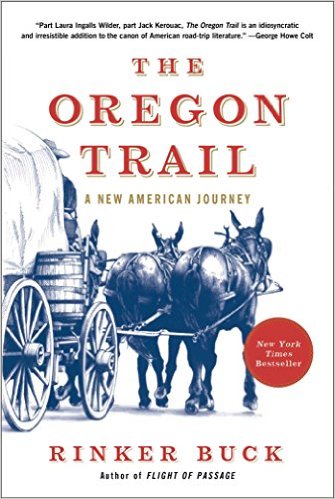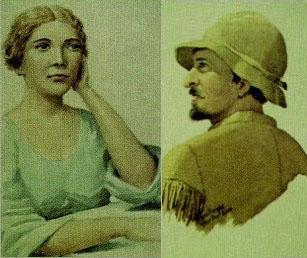I have immersed myself in the nineteenth century over the last few weeks, editing my Oregon Trail novel for what I hope has been the final big push. It still needs some tweaking, but the book is essentially done.
 While I was spending hours each day deep in my novel, I read each evening from The Oregon Trail: A New American Journey, by Rinker Buck. Mr. Buck and his brother Nick drove a covered wagon powered by three mules from Kansas to Oregon in 2011. Their family background gave them unique skills to tackle this endeavor—their father had taken them on many covered wagon rides in the East when they were growing up. As an adult, Nick was a master mechanic and muleskinner.
While I was spending hours each day deep in my novel, I read each evening from The Oregon Trail: A New American Journey, by Rinker Buck. Mr. Buck and his brother Nick drove a covered wagon powered by three mules from Kansas to Oregon in 2011. Their family background gave them unique skills to tackle this endeavor—their father had taken them on many covered wagon rides in the East when they were growing up. As an adult, Nick was a master mechanic and muleskinner.
Rinker Buck’s book is part memoir, part history, part travelogue, and part social commentary. All parts are enjoyable.
It was a good counterpoint for me as I worked my way through my novel, giving me a foil against which either to confirm what I wrote about my emigrants or to understand why my account differed from what the Bucks experienced.
I had to remind myself as I read that Mr. Buck could recount the entire history of the Oregon Trail, from Lewis and Clark through the 1890s. He includes accounts of the Mormon migration and influence, the Gold Rush years, and the Pony Express. I, on the other hand, have been limited to writing about the trail as it existed in 1847—the year my fictional wagon train heads to Oregon.
So each time I said “Yeah, but . . .” as I read, I re-grounded myself in his purpose and in my purpose, and then went back to Mr. Buck’s story, which was engrossing in every way. And I fixed one error in my manuscript that I caught while reading his book.
Mr. Buck tells his readers up front that his journey was not a reenactment of the Oregon Trail emigrants. They used a nineteenth century wagon designed along the same specifications as the emigrant wagons. They rigged their mule harnesses the same way. But they made many adaptations, such as pulling an extra cart behind their wagon (the ill-fated Trail Pup which hauled extra water and mule feed).
And they didn’t shun modern conveniences and facilities along the way. They traveled part of the route on asphalt roads. When their equipment broke down, they found ranchers to help them with repairs or sent broken gear back East to be fixed. They camped frequently in public parks and corrals or on ranches through which they traveled. At one point, a minivan’s headlights guided them into camp. They bought clothes at Wal-Mart and food in grocery stores. (I had to laugh when Mr. Buck described stopping at a diner for fried chicken. No diners available in 1847.)
But the Bucks faced many of the same problems the nineteenth century emigrants did. They planned their route from water source to water source. They had to chuck belongings along the way to reduce weight. Rinker Buck escaped the discomfort and monotony of the wagon by walking for at least part of the day while his brother drove. And weather turned from pleasant to treacherous in the space of minutes.
I discovered that the emigrants of the nineteenth century had some advantages that the Buck brothers did not. For one, the wagon trains didn’t have to worry about cattle guards.
But more importantly, as Mr. Buck points out, the emigrants could pool their resources—food and water, tools, and the labor that dozens of men and teams could provide. I had intuited the sense of community that wagon trains developed along the trail, but in my novel, their forced togetherness also provides a lot of the conflict in the story.
Despite its lack of authenticity in some respects, Mr. Buck’s book is still an excellent resource for anyone interested in the Oregon Trail. He provides more detail on wagon construction and mule driving than any of the books I previously encountered in my research. (He made an excellent case for mules over oxen, though other wagoneers made equally strong cases for oxen.)
He also provides pictures and drawings that show the particulars of their wagon construction, the harnessing of their mules, and the beauty of the land they traversed. His descriptions of locales in the West jibed with first-hand accounts from the nineteenth century. Moreover, he and his brother encountered many of the same dangers (thunderstorms, steep ascents and descents, lack of water, and runaway mules) that pioneers in the nineteenth century faced.

I have always been fascinated by the story of Narcissa Whitman, and it seems Rinker Buck was as well. Narcissa was the first white woman to cross the Rockies and settle in Oregon. Her spunk and vitality encouraged me from the time I first visited the Whiman Mission outside Walla Walla, Washington, when I was about eight. Like Mr. Buck, as I learned more about her attitude of white superiority toward the Native Americans she sought to convert, I discovered she was an imperfect heroine. Nevertheless, her story spurred many emigrant women to settle in the West, and it started me on the path to writing about the Oregon Trail.
Mr. Buck expertly weaves personal memoir and public history into his chronology of the journey. As with any meaningful journey experience, he and his brother come out with changed perspectives on life. Mr. Buck generously shares those perspectives with his readers. We end up wondering: Could I survive such a trek? What would it change in me?
I highly recommend The Oregon Trail: A New American Journey as a good read, as well as an informed view on an important period in American history.
What books have immersed you in another time?
P.S. I’m also in the middle of Pioneer Girl by Laura Ingalls Wilder, as edited and annotated by Pamela Smith Hill. This book provides another glimpse into the nineteenth century. It’s also worth a read, if you don’t mind learning the truth behind some of the tales in the beloved Little House books.




I saw that book reviewed in WSJ and meant to recommend it to you… and forgot. Glad you found it on your own. Also, I think you mean “jibe” not “jive.” I looked it up because I am forever confused on that one, too.
Martha, thanks for catching this error. All fixed now.
Theresa